Dosing & Uses
Dosage Forms & Strengths
capsule
- 1.5mg
- 3mg
- 4.5mg
- 6mg
transdermal patch
- 4.6mg/24hr
- 9.5mg/24hr
- 13.3mg/24hr
Alzheimer Dementia
Oral
- Indicated for mild-to-moderate dementia of the Alzheimer's type
- Initial: 1.5 mg PO q12hr
- Increase by 1.5 mg/dose q2Weeks; not to exceed 6 mg PO q12hr
- Maintenance: 3-6 mg PO q12hr (higher end may be more beneficial)
Transdermal
- Indicated for mild, moderate, and severe dementia of the Alzheimer's type
- Initial: Apply 4.6 mg q24hr
- Dose titration: May increase dose to 9.5 mg q24hr after a minimum 4 weeks if well tolerated; after an additional 4 weeks, may further increase to 13.3 mg patch if needed
- Mild-to-moderate Alzheimer disease: Effective dosage range is 9.5-13.3 mg/24 hr
- Moderate-to-severe Alzheimer disease: Effective dose is 13.3 mg/24 hr
- Replace with new patch q24hr
Parkinson Dementia
Oral
- Initial: 1.5 mg PO q12hr
- Increase by 1.5 mg/dose q4Weeks; not to exceed 6 mg PO q12hr
- Maintenance: 1.5-6 mg PO q12hr
Transdermal
- Initial: Apply 4.6 mg q24hr
- May increase dose to 9.5 mg q24hr after a minimum 4 weeks if well tolerated; after an additional 4 weeks, may further increase to 13.3 mg patch if needed
Dosage Modifications
Interruption of treatment (Oral)
- If adverse effects (e.g., nausea, vomiting, abdominal pain, loss of appetite) cause intolerance during treatment, patient should be instructed to discontinue treatment for several doses ; if dosing is interrupted for ≤3, restart treatment with same or lower dose; if dosing is interrupted for >3 days, restart treatment with 1.5 mg twice a day and titrate as described above
Interruption of treatment (Patch)
- If dosing is interrupted for ≤3 days, restart treatment with same or lower strength patch; if dosing is interrupted for >3 days, restart treatment with 4.6 mg/24 hours patch and titrate as described above
Renal impairment
- Oral: Patients with moderate and severe renal impairment may be able to only tolerate lower doses
- Transdermal: Not studied; dosage adjustment may not be required
Hepatic impairment
- Mild-to-moderate hepatic impairment (Child-Pugh class A and B): 1.5 mg qDay with slow titration recommended for oral administration; transdernal patch, not to exceed 4.6 mg q24hr
- Severe hepatic impairment: Not studied
Low body weight (<50 kg)
- Carefully titrate and monitor patients for toxicities (eg, excessive nausea, vomiting), and consider reducing maintenance dose if toxicities develop while taking orally; reduce to 4.6 mg q24hr if toxicities develop with transdermal patch
Administration
Take with food
Oral solution may be swallowed directly from provided syringe or mixed with small glass of fluid
Switching from oral to transdermal
- If PO dose <6 mg/day, switch to 4.6 mg/24 hr patch
- If PO dose is 6-12 mg/day, switch to 9.5 mg/24 hr patch
- Apply patch on day following last oral dose
Not applicable
Interactions
Interaction Checker
No Results

Contraindicated
Serious - Use Alternative
Significant - Monitor Closely
Minor

Contraindicated (0)
Serious - Use Alternative (14)
- atenolol
atenolol increases toxicity of rivastigmine by pharmacodynamic synergism. Avoid or Use Alternate Drug. Additive bradycardia effect may result in syncope.
- betaxolol
betaxolol increases toxicity of rivastigmine by pharmacodynamic synergism. Avoid or Use Alternate Drug. Additive bradycardia effect may result in syncope.
- bisoprolol
bisoprolol increases toxicity of rivastigmine by pharmacodynamic synergism. Avoid or Use Alternate Drug. Additive bradycardia effect may result in syncope.
- esmolol
esmolol increases toxicity of rivastigmine by pharmacodynamic synergism. Avoid or Use Alternate Drug. Additive bradycardia effect may result in syncope.
- levobunolol
levobunolol increases toxicity of rivastigmine by pharmacodynamic synergism. Avoid or Use Alternate Drug. Additive bradycardia effect may result in syncope.
- metoclopramide
rivastigmine, metoclopramide. Either increases toxicity of the other by antidopaminergic effects, including extrapyramidal symptoms and neuroleptic malignant syndrome. Avoid or Use Alternate Drug.
metoclopramide, rivastigmine. Either increases toxicity of the other by antidopaminergic effects, including extrapyramidal symptoms and neuroleptic malignant syndrome. Avoid or Use Alternate Drug. - metoprolol
metoprolol increases toxicity of rivastigmine by pharmacodynamic synergism. Avoid or Use Alternate Drug. Additive bradycardia effect may result in syncope.
- nadolol
nadolol increases toxicity of rivastigmine by pharmacodynamic synergism. Avoid or Use Alternate Drug. Additive bradycardia effect may result in syncope.
- nebivolol
nebivolol increases toxicity of rivastigmine by pharmacodynamic synergism. Avoid or Use Alternate Drug. Additive bradycardia effect may result in syncope.
- ponesimod
ponesimod, rivastigmine. Either increases effects of the other by pharmacodynamic synergism. Avoid or Use Alternate Drug. Consult cardiologist if considering treatment. Coadministration of ponesimod with drugs that decrease HR may have additive effects on decreasing HR and should generally not be initiated in these patients.
- propranolol
propranolol increases toxicity of rivastigmine by pharmacodynamic synergism. Avoid or Use Alternate Drug. Additive bradycardia effect may result in syncope.
- sotalol
sotalol increases toxicity of rivastigmine by pharmacodynamic synergism. Avoid or Use Alternate Drug. Additive bradycardia effect may result in syncope.
- timolol
timolol increases toxicity of rivastigmine by pharmacodynamic synergism. Avoid or Use Alternate Drug. Additive bradycardia effect may result in syncope.
- triamcinolone acetonide injectable suspension
triamcinolone acetonide injectable suspension, rivastigmine. unspecified interaction mechanism. Avoid or Use Alternate Drug. Concomitant use of anticholinesterase agents and corticosteroids may produce severe weakness in patients with myasthenia gravis. If possible, withdraw anticholinesterase agents at least 24 hours before initiating corticosteroid therapy.
Monitor Closely (53)
- aclidinium
rivastigmine increases and aclidinium decreases cholinergic effects/transmission. Effect of interaction is not clear, use caution. Use Caution/Monitor.
- amifampridine
amifampridine and rivastigmine both increase cholinergic effects/transmission. Use Caution/Monitor.
- amitriptyline
rivastigmine increases and amitriptyline decreases cholinergic effects/transmission. Effect of interaction is not clear, use caution. Modify Therapy/Monitor Closely.
- aspirin
rivastigmine increases toxicity of aspirin by pharmacodynamic synergism. Use Caution/Monitor. Monitor patients for symptoms of active or occult gastrointestinal bleeding.
- atropine IV/IM
rivastigmine increases and atropine IV/IM decreases cholinergic effects/transmission. Effect of interaction is not clear, use caution. Use Caution/Monitor. .
- bethanechol
bethanechol and rivastigmine both increase cholinergic effects/transmission. Use Caution/Monitor.
rivastigmine and bethanechol both increase cholinergic effects/transmission. Use Caution/Monitor. - carbachol
carbachol and rivastigmine both increase cholinergic effects/transmission. Use Caution/Monitor.
- celecoxib
rivastigmine increases toxicity of celecoxib by pharmacodynamic synergism. Use Caution/Monitor. Monitor patients for symptoms of active or occult gastrointestinal bleeding.
- cevimeline
cevimeline and rivastigmine both increase cholinergic effects/transmission. Use Caution/Monitor.
rivastigmine and cevimeline both increase decreasing elimination. Use Caution/Monitor. - clomipramine
rivastigmine increases and clomipramine decreases cholinergic effects/transmission. Effect of interaction is not clear, use caution. Use Caution/Monitor.
- darifenacin
darifenacin decreases effects of rivastigmine by cholinergic effects/transmission. Use Caution/Monitor.
- dichlorphenamide
dichlorphenamide and rivastigmine both decrease serum potassium. Use Caution/Monitor.
- diclofenac
rivastigmine increases toxicity of diclofenac by pharmacodynamic synergism. Use Caution/Monitor. Monitor patients for symptoms of active or occult gastrointestinal bleeding.
- diflunisal
rivastigmine increases toxicity of diflunisal by pharmacodynamic synergism. Use Caution/Monitor. Monitor patients for symptoms of active or occult gastrointestinal bleeding.
- donepezil
donepezil and rivastigmine both increase cholinergic effects/transmission. Use Caution/Monitor.
- doxepin
rivastigmine increases and doxepin decreases cholinergic effects/transmission. Effect of interaction is not clear, use caution. Use Caution/Monitor.
- echothiophate iodide
echothiophate iodide and rivastigmine both increase cholinergic effects/transmission. Use Caution/Monitor.
- etodolac
rivastigmine increases toxicity of etodolac by pharmacodynamic synergism. Use Caution/Monitor. Monitor patients for symptoms of active or occult gastrointestinal bleeding.
- fenoprofen
rivastigmine increases toxicity of fenoprofen by pharmacodynamic synergism. Use Caution/Monitor. Monitor patients for symptoms of active or occult gastrointestinal bleeding.
- fesoterodine
fesoterodine decreases effects of rivastigmine by cholinergic effects/transmission. Use Caution/Monitor.
- flurbiprofen
rivastigmine increases toxicity of flurbiprofen by pharmacodynamic synergism. Use Caution/Monitor. Monitor patients for symptoms of active or occult gastrointestinal bleeding.
- galantamine
galantamine and rivastigmine both increase cholinergic effects/transmission. Use Caution/Monitor.
- glycopyrrolate inhaled
rivastigmine increases and glycopyrrolate inhaled decreases cholinergic effects/transmission. Effect of interaction is not clear, use caution. Use Caution/Monitor.
- hyoscyamine spray
rivastigmine increases and hyoscyamine spray decreases cholinergic effects/transmission. Effect of interaction is not clear, use caution. Use Caution/Monitor. .
- ibuprofen
rivastigmine increases toxicity of ibuprofen by pharmacodynamic synergism. Use Caution/Monitor. Monitor patients for symptoms of active or occult gastrointestinal bleeding.
- ibuprofen IV
rivastigmine increases toxicity of ibuprofen IV by pharmacodynamic synergism. Use Caution/Monitor. Monitor patients for symptoms of active or occult gastrointestinal bleeding.
- indomethacin
rivastigmine increases toxicity of indomethacin by pharmacodynamic synergism. Use Caution/Monitor. Monitor patients for symptoms of active or occult gastrointestinal bleeding.
- ketoprofen
rivastigmine increases toxicity of ketoprofen by pharmacodynamic synergism. Use Caution/Monitor. Monitor patients for symptoms of active or occult gastrointestinal bleeding.
- ketorolac
rivastigmine increases toxicity of ketorolac by pharmacodynamic synergism. Use Caution/Monitor. Monitor patients for symptoms of active or occult gastrointestinal bleeding.
- maprotiline
rivastigmine increases and maprotiline decreases cholinergic effects/transmission. Effect of interaction is not clear, use caution. Use Caution/Monitor.
- meclofenamate
rivastigmine increases toxicity of meclofenamate by pharmacodynamic synergism. Use Caution/Monitor. Monitor patients for symptoms of active or occult gastrointestinal bleeding.
- mefenamic acid
rivastigmine increases toxicity of mefenamic acid by pharmacodynamic synergism. Use Caution/Monitor. Monitor patients for symptoms of active or occult gastrointestinal bleeding.
- meloxicam
rivastigmine increases toxicity of meloxicam by pharmacodynamic synergism. Use Caution/Monitor. Monitor patients for symptoms of active or occult gastrointestinal bleeding.
- nabumetone
rivastigmine increases toxicity of nabumetone by pharmacodynamic synergism. Use Caution/Monitor. Monitor patients for symptoms of active or occult gastrointestinal bleeding.
- naproxen
rivastigmine increases toxicity of naproxen by pharmacodynamic synergism. Use Caution/Monitor. Monitor patients for symptoms of active or occult gastrointestinal bleeding.
- neostigmine
neostigmine and rivastigmine both increase cholinergic effects/transmission. Use Caution/Monitor.
- oxaprozin
rivastigmine increases toxicity of oxaprozin by pharmacodynamic synergism. Use Caution/Monitor. Monitor patients for symptoms of active or occult gastrointestinal bleeding.
- oxybutynin
oxybutynin and rivastigmine both decrease cholinergic effects/transmission. Use Caution/Monitor.
- oxybutynin transdermal
rivastigmine increases and oxybutynin transdermal decreases cholinergic effects/transmission. Effect of interaction is not clear, use caution. Use Caution/Monitor.
- physostigmine
physostigmine and rivastigmine both increase cholinergic effects/transmission. Use Caution/Monitor.
- pilocarpine
pilocarpine and rivastigmine both increase cholinergic effects/transmission. Use Caution/Monitor.
rivastigmine and pilocarpine both increase cholinergic effects/transmission. Use Caution/Monitor. - piroxicam
rivastigmine increases toxicity of piroxicam by pharmacodynamic synergism. Use Caution/Monitor. Monitor patients for symptoms of active or occult gastrointestinal bleeding.
- pralidoxime
rivastigmine increases and pralidoxime decreases cholinergic effects/transmission. Effect of interaction is not clear, use caution. Use Caution/Monitor.
- protriptyline
rivastigmine increases and protriptyline decreases cholinergic effects/transmission. Effect of interaction is not clear, use caution. Use Caution/Monitor.
- pyridostigmine
pyridostigmine and rivastigmine both increase cholinergic effects/transmission. Use Caution/Monitor.
- salicylates (non-asa)
rivastigmine increases toxicity of salicylates (non-asa) by pharmacodynamic synergism. Use Caution/Monitor. Monitor patients for symptoms of active or occult gastrointestinal bleeding.
- salsalate
rivastigmine increases toxicity of salsalate by pharmacodynamic synergism. Use Caution/Monitor. Monitor patients for symptoms of active or occult gastrointestinal bleeding.
- solifenacin
solifenacin decreases effects of rivastigmine by cholinergic effects/transmission. Use Caution/Monitor.
- succinylcholine
rivastigmine and succinylcholine both increase cholinergic effects/transmission. Use Caution/Monitor. Potential for prolonged neuromuscular blockade. Rivastigmine may increase serum concentration of succinylcholine.
- sulindac
rivastigmine increases toxicity of sulindac by pharmacodynamic synergism. Use Caution/Monitor. Monitor patients for symptoms of active or occult gastrointestinal bleeding.
- tolmetin
rivastigmine increases toxicity of tolmetin by pharmacodynamic synergism. Use Caution/Monitor. Monitor patients for symptoms of active or occult gastrointestinal bleeding.
- tolterodine
tolterodine and rivastigmine both decrease cholinergic effects/transmission. Use Caution/Monitor.
- trospium chloride
trospium chloride decreases effects of rivastigmine by cholinergic effects/transmission. Use Caution/Monitor.
Minor (6)
- aspirin rectal
rivastigmine increases toxicity of aspirin rectal by pharmacodynamic synergism. Minor/Significance Unknown. Increased GI symptoms.
- aspirin/citric acid/sodium bicarbonate
rivastigmine increases toxicity of aspirin/citric acid/sodium bicarbonate by pharmacodynamic synergism. Minor/Significance Unknown. Increased GI symptoms.
- choline magnesium trisalicylate
rivastigmine increases toxicity of choline magnesium trisalicylate by pharmacodynamic synergism. Minor/Significance Unknown. Increased GI symptoms.
- desipramine
rivastigmine increases and desipramine decreases cholinergic effects/transmission. Effect of interaction is not clear, use caution. Minor/Significance Unknown.
- ketorolac intranasal
rivastigmine increases toxicity of ketorolac intranasal by pharmacodynamic synergism. Minor/Significance Unknown. Increased GI symptoms.
- trazodone
rivastigmine increases and trazodone decreases cholinergic effects/transmission. Effect of interaction is not clear, use caution. Minor/Significance Unknown.
Adverse Effects
>10%
Nausea (PO 47%; patch 21%)
Vomiting (PO 31%; patch 6-19%)
Dizziness (PO 21%; patch 2-7%)
Diarrhea (PO 19%; patch 6-10%)
Headache (PO 17%; patch 3-4%)
Anorexia (PO 17%; patch 3-9%)
Abdominal pain (PO 13%; patch 2-4%)
1-10%
Decreased weight (3-8%)
Insomnia (PO 9%; patch 1-4%)
Anxiety (PO 5%; patch 3%)
Asthenia (PO 6%; patch 2-3%)
Vertigo (2%)
Fatigue (2%)
Postmarketing Reports
Cardiac Disorders: Tachycardia, QTc prolongation, torsades de pointes
Hepatobiliary Disorders: Abnormal liver function tests, hepatitis
Nervous System Disorders: Seizure
Psychiatric Disorders: Aggression, nightmares
Skin and Subcutaneous Tissue Disorders: Allergic dermatitis, application site hypersensitivity (patch), blister, disseminated allergic dermatitis, Stevens-Johnson syndrome, urticarial
Warnings
Contraindications
Hypersensitivity to rivastigmine or carbamates
History of application site reaction with transdermal patch
Active GI bleeding
Cautions
Anorexia
Sick sinus syndrome
History of peptic ulcer
History of asthma/COPD
May induce/exacerbate extrapyramidal symptoms
Concomitant NSAID
Gastrointestinal adverse reactions may include significant nausea, vomiting, diarrhea, anorexia/decreased appetite, and weight loss, and may necessitate treatment interruption; dehydration may result from prolonged vomiting or diarrhea and can be associated with serious outcomes
Medication errors with transdermal patches have resulted in serious adverse events; some cases have required hospitalization, and in rare instances, medication errors have led to death; most of the errors have involved not removing the old patch when putting on a new one and the use of multiple patches at the same time
Skin application site reactions may occur with transdermal application and are usually mild or moderate in intensity; these reactions are not in themselves an indication of sensitization; however, use of rivastigmine patch may lead to allergic contact dermatitis
Isolated postmarketing reports of disseminated hypersensitivity reactions of the skin irrespective of the administration route (oral or transdermal); treatment should be discontinued if disseminated hypersensitivity reaction of the skin occurs
Pregnancy & Lactation
Pregnancy
There are no adequate data on developmental risks associated with use of drug in pregnant women
Animal data
- In animals, no adverse effects on embryo-fetal development were observed at oral doses 2-4 times maximum recommended human dose (MRHD)
Lactation
There are no data on presence of drug in human milk, effects on breastfed infant, or on milk production; the drug and its metabolites are excreted in rat milk following oral administration of rivastigmine; levels of rivastigmine plus metabolites in rat milk are approximately 2 times that in maternal plasma; developmental and health benefits of breastfeeding should be considered along with mother’s clinical need for therapy and any potential adverse effects on breastfed infant from drug or underlying maternal condition
Pregnancy Categories
A: Generally acceptable. Controlled studies in pregnant women show no evidence of fetal risk.
B: May be acceptable. Either animal studies show no risk but human studies not available or animal studies showed minor risks and human studies done and showed no risk. C: Use with caution if benefits outweigh risks. Animal studies show risk and human studies not available or neither animal nor human studies done. D: Use in LIFE-THREATENING emergencies when no safer drug available. Positive evidence of human fetal risk. X: Do not use in pregnancy. Risks involved outweigh potential benefits. Safer alternatives exist. NA: Information not available.Pharmacology
Mechanism of Action
Reversible acetylcholinesterase inhibitor that causes an increase in concentrations of acetylcholine, which in turn enhances cholinergic neurotransmission
Absorption
Bioavailability: 36% (PO)
Duration: 10 hr (PO); 24 hr (patch)
Peak plasma time: 1 hr (PO); 8 hr (patch)
Distribution
Protein bound: 40%
Vd: 1.8-2.7 L/kg
Metabolism
Metabolized by cholinesterase
Elimination
Half-life: 1.5 hr (PO), 3 hr (patch)
Total body clearance: 1.2-2.4 L/min
Excretion: Urine (97%)
Images
| BRAND | FORM. | UNIT PRICE | PILL IMAGE |
|---|---|---|---|
| Exelon transdermal - | 13.3 mg/24 hour transdermal system | 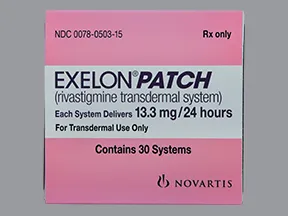 | |
| Exelon transdermal - | 9.5 mg/24 hour transdermal system | 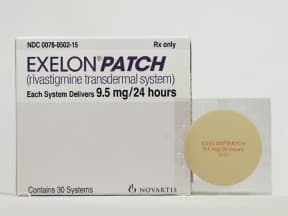 | |
| Exelon transdermal - | 4.6 mg/24 hour transdermal system | 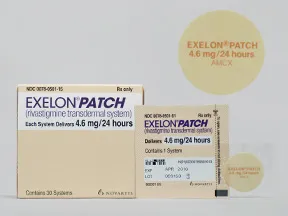 | |
| Exelon transdermal - | 4.6 mg/24 hour transdermal system | 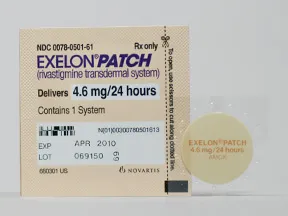 | |
| Exelon transdermal - | 9.5 mg/24 hour transdermal system | 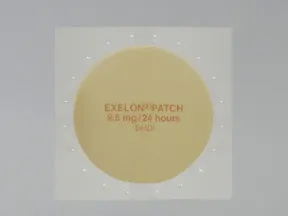 | |
| rivastigmine transdermal - | 9.5 mg/24 hour transdermal system | 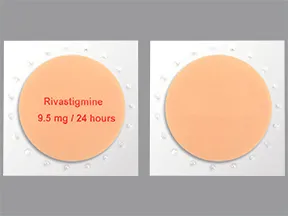 | |
| rivastigmine transdermal - | 4.6 mg/24 hour transdermal system | 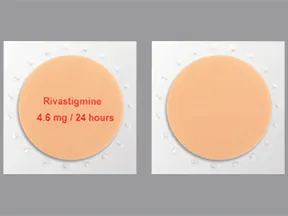 | |
| rivastigmine transdermal - | 9.5 mg/24 hour transdermal system | 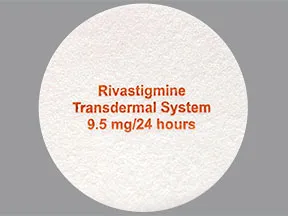 | |
| rivastigmine transdermal - | 4.6 mg/24 hour transdermal system | 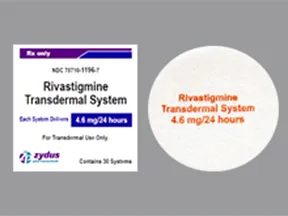 | |
| rivastigmine transdermal - | 13.3 mg/24 hour transdermal system |  | |
| rivastigmine transdermal - | 9.5 mg/24 hour transdermal system |  | |
| rivastigmine transdermal - | 4.6 mg/24 hour transdermal system | 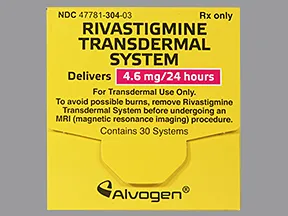 | |
| rivastigmine transdermal - | 13.3 mg/24 hour transdermal system |  | |
| rivastigmine transdermal - | 9.5 mg/24 hour transdermal system | 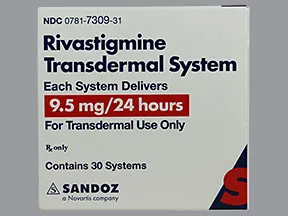 | |
| rivastigmine transdermal - | 4.6 mg/24 hour transdermal system | 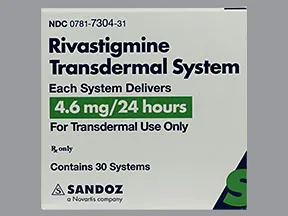 | |
| rivastigmine transdermal - | 13.3 mg/24 hour transdermal system | 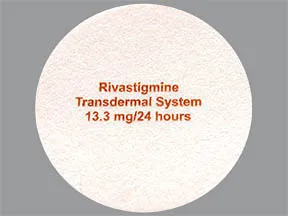 | |
| rivastigmine transdermal - | 9.5 mg/24 hour transdermal system | 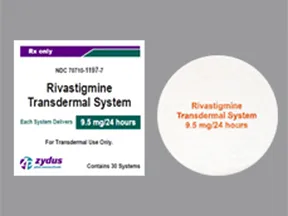 | |
| rivastigmine transdermal - | 4.6 mg/24 hour transdermal system | 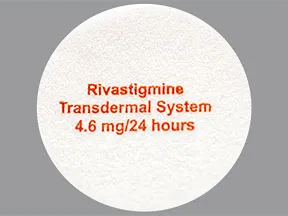 | |
| rivastigmine transdermal - | 13.3 mg/24 hour transdermal system | 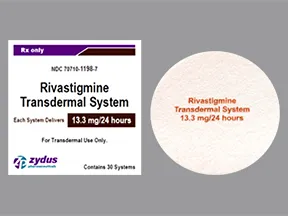 | |
| rivastigmine transdermal - | 9.5 mg/24 hour transdermal system | 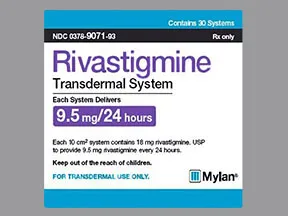 | |
| rivastigmine transdermal - | 13.3 mg/24 hour transdermal system | 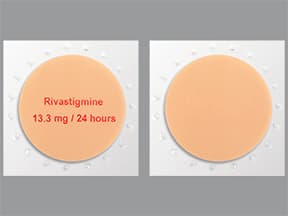 |
Copyright © 2010 First DataBank, Inc.
Patient Handout
rivastigmine transdermal
RIVASTIGMINE PATCH - TRANSDERMAL
(riv-uh-STIG-meen)
COMMON BRAND NAME(S): Exelon
USES: Rivastigmine is used to treat confusion (dementia) related to Alzheimer's disease and to Parkinson's disease. Rivastigmine does not cure either of these diseases, but it may improve memory, awareness, and the ability to perform daily functions. This medication works by restoring the balance of natural substances (neurotransmitters) in the brain.
HOW TO USE: Read the Patient Information Leaflet if available from your pharmacist before you start using this medication and each time you get a refill. Follow all instructions for how to properly apply and use the patches. If you have any questions, consult your doctor or pharmacist.Apply the patch to the skin as directed by your doctor, usually once daily. Do not open the sealed pouch until ready to use. Open the pouch and remove the patch from the protective liner. Do not cut the patch. Apply the patch as directed to a clean, dry, hairless area on the back, upper arm, or chest. Remove the old patch first before applying a new patch. Do not wear 2 patches at the same time. Do not apply the patch to red/irritated/broken areas of skin or to areas where you have applied creams or lotions. Avoid applying it to areas where tight clothing may rub the patch off. You can bathe with the patch on.When changing your patch, remove the old patch, fold it in half with the sticky sides together, and throw it away out of reach of children and pets. Apply a new patch to a different area to prevent skin irritation. Do not apply a new patch to the same area for at least 2 weeks.If the patch falls off before it is due to be changed, apply a new patch right away and replace the new patch at the regularly scheduled time the next day. Do not try to reapply the old patch or use tape to keep a loose patch from falling off.Do not touch your eyes while you are handling the patch. Wash your hands with soap and water after each application. If the medication comes in contact with your eyes or if your eyes become red after handling the patch, rinse your eyes right away with water. Tell your doctor if the redness or other symptoms do not go away.Dosage is based on your medical condition and response to treatment. To reduce your risk of side effects (such as nausea and diarrhea), your doctor will start this medication using a lower dose of the patch and may increase your dose after 4 weeks. Follow your doctor's instructions carefully. Do not increase your dose or use this drug more often than prescribed. Do not apply more than one patch per day or leave the patch on for longer than prescribed. Your condition will not improve any faster, and your risk of side effects will increase.Use this medication regularly to get the most benefit from it. To help you remember, change your patch at the same time each day.If you do not use rivastigmine for 3 or more days in row, talk with your doctor before starting again. You may need to restart at a lower dose.Tell your doctor if your condition worsens.
SIDE EFFECTS: Nausea, vomiting, loss of appetite/weight loss, diarrhea, weakness, dizziness, drowsiness, shakiness (tremors), and skin irritation at the application site may occur. If any of these effects last or get worse, contact your doctor or pharmacist promptly.Remember that this medication has been prescribed because your doctor has judged that the benefit to you is greater than the risk of side effects. Many people using this medication do not have serious side effects.Tell your doctor right away if any of these serious side effects occur: slow heartbeat, black stools, vomit that looks like coffee grounds, severe stomach/abdominal pain, seizures, trouble urinating.Get medical help right away if you have any very serious side effects, including: fast/irregular heartbeat, severe dizziness, fainting.A very serious allergic reaction to this drug is rare. However, get medical help right away if you notice any symptoms of a serious allergic reaction, including: rash, itching/swelling (especially of the face/tongue/throat), severe dizziness, trouble breathing.This is not a complete list of possible side effects. If you notice other effects not listed above, contact your doctor or pharmacist.In the US -Call your doctor for medical advice about side effects. You may report side effects to FDA at 1-800-FDA-1088 or at www.fda.gov/medwatch.In Canada - Call your doctor for medical advice about side effects. You may report side effects to Health Canada at 1-866-234-2345.
PRECAUTIONS: Before using rivastigmine, tell your doctor or pharmacist if you are allergic to it (including any serious allergic skin reaction with past use of the patch); or if you have any other allergies. This product may contain inactive ingredients, which can cause allergic reactions or other problems. Talk to your pharmacist for more details.Before using this medication, tell your doctor or pharmacist your medical history, especially of: breathing/lung problems (such as asthma, COPD-chronic obstructive pulmonary disease), stomach/intestinal problems (such as ulcers, bleeding), heart problems (such as sick sinus syndrome, other conduction disorders), fainting, seizures, problems urinating (such as due to enlarged prostate), liver disease.Rivastigmine may cause a condition that affects the heart rhythm (QT prolongation). QT prolongation can rarely cause serious (rarely fatal) fast/irregular heartbeat and other symptoms (such as severe dizziness, fainting) that need medical attention right away.The risk of QT prolongation may be increased if you have certain medical conditions or are taking other drugs that may cause QT prolongation. Before using rivastigmine, tell your doctor or pharmacist of all the drugs you take and if you have any of the following conditions: certain heart problems (heart failure, slow heartbeat, QT prolongation in the EKG), family history of certain heart problems (QT prolongation in the EKG, sudden cardiac death).Low levels of potassium or magnesium in the blood may also increase your risk of QT prolongation. This risk may increase if you use certain drugs (such as diuretics/"water pills") or if you have conditions such as severe sweating, diarrhea, or vomiting. Talk to your doctor about using rivastigmine safely.This drug may make you dizzy or drowsy. Alcohol or marijuana (cannabis) can make you more dizzy or drowsy. Do not drive, use machinery, or do anything that needs alertness until you can do it safely. Limit alcoholic beverages. Talk to your doctor if you are using marijuana (cannabis).While wearing your patch, avoid exposing it to direct heat (such as prolonged direct sunlight, heating pads, electric blankets, heat lamps, saunas, hot tubs). Heat may cause more drug to be released into your body, increasing the chance of side effects.If you are going to have an MRI test, tell testing personnel that you are using this patch. Some patches may contain metals that can cause serious burns during an MRI. Ask your doctor whether you will need to remove your patch before the test and apply a new patch afterward, and how to do so properly.Before having surgery, tell your doctor or dentist about all the products you use (including prescription drugs, nonprescription drugs, and herbal products).Older adults may be more sensitive to the side effects of this drug, especially QT prolongation (see above).During pregnancy, this medication should be used only when clearly needed. Discuss the risks and benefits with your doctor.It is unknown if this medication passes into breast milk. Consult your doctor before breastfeeding.
DRUG INTERACTIONS: Drug interactions may change how your medications work or increase your risk for serious side effects. This document does not contain all possible drug interactions. Keep a list of all the products you use (including prescription/nonprescription drugs and herbal products) and share it with your doctor and pharmacist. Do not start, stop, or change the dosage of any medicines without your doctor's approval.Some products that may interact with this drug include: aspirin/nonsteroidal anti-inflammatory drugs (NSAIDs, such as ibuprofen, naproxen), metoclopramide.Check all prescription and nonprescription medicine labels carefully since many medications contain pain relievers/fever reducers (NSAIDs such as aspirin, ibuprofen, or naproxen) that if taken together with rivastigmine may increase your risk for stomach/intestinal bleeding. However, if your doctor has told you to take low-dose aspirin to prevent heart attack or stroke (usually 81-162 milligrams a day), you should keep taking the aspirin unless your doctor tells you not to. Ask your doctor or pharmacist for more details.
OVERDOSE: This medication patch may be harmful if chewed or swallowed. If someone has overdosed, remove the patch if possible. For serious symptoms such as passing out or trouble breathing, call 911. Otherwise, call a poison control center right away. US residents can call 1-800-222-1222. Canada residents can call 1-844-764-7669. Symptoms of overdose may include: nausea/vomiting that is severe or doesn't stop, excessive sweating, very slow heartbeat, slow or shallow breathing, seizure.
NOTES: Do not share this medication with others.Your doctor should check your weight periodically to monitor for side effects.
MISSED DOSE: If you miss a dose, use it as soon as you remember. Replace the new patch at the regularly scheduled time the next day. Do not use 2 patches to catch up.
STORAGE: Store at room temperature away from light and moisture. Do not store in the bathroom. Keep all medications away from children and pets.Do not flush medications down the toilet or pour them into a drain unless instructed to do so. Properly discard this product when it is expired or no longer needed. Consult your pharmacist or local waste disposal company.
Information last revised May 2024. Copyright(c) 2024 First Databank, Inc.
IMPORTANT: HOW TO USE THIS INFORMATION: This is a summary and does NOT have all possible information about this product. This information does not assure that this product is safe, effective, or appropriate for you. This information is not individual medical advice and does not substitute for the advice of your health care professional. Always ask your health care professional for complete information about this product and your specific health needs.
Formulary
Adding plans allows you to compare formulary status to other drugs in the same class.
To view formulary information first create a list of plans. Your list will be saved and can be edited at any time.
Adding plans allows you to:
- View the formulary and any restrictions for each plan.
- Manage and view all your plans together – even plans in different states.
- Compare formulary status to other drugs in the same class.
- Access your plan list on any device – mobile or desktop.









